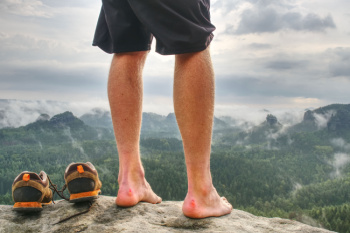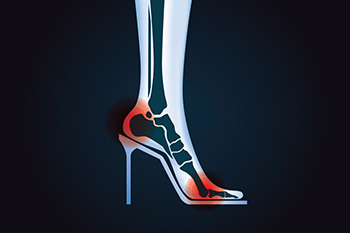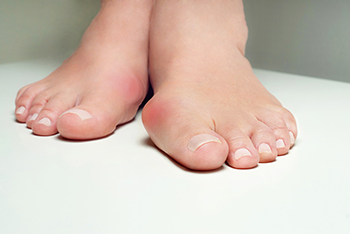Dr. Kennan T. Runte, DPM, FACFAS
Dr. Panah Nabili, DPM
Grass Valley, CA 95945
Dr. Kennan T. Runte, DPM, FACFAS
Dr. Panah Nabili, DPM

Painful foot injuries can significantly impact daily life. One common issue is neuromas, painful nerve tumors typically occurring between the toes. Stress fractures, often caused by overuse or sudden increases in activity, result in tiny cracks in the foot bones and cause sharp pain. Plantar fasciitis involves inflammation of the band of tissue running along the bottom of the foot, leading to heel pain, that is noticeable in the morning. Heel spurs on the other hand are bony growths on the heel bone that can cause pain during movement. Foot pain can cause difficulty in completing daily activities. If you have pain in any area of your foot, it is strongly suggested that you schedule an appointment with a podiatrist who can offer appropriate treatment solutions.
Foot Pain
Foot pain can be extremely painful and debilitating. If you have a foot pain, consult with one of our podiatrists from Foothill Podiatry Clinic. Our doctors will assess your condition and provide you with quality foot and ankle treatment.
Causes
Foot pain is a very broad condition that could be caused by one or more ailments. The most common include:
Diagnosis
To figure out the cause of foot pain, podiatrists utilize several different methods. This can range from simple visual inspections and sensation tests to X-rays and MRI scans. Prior medical history, family medical history, and any recent physical traumatic events will all be taken into consideration for a proper diagnosis.
Treatment
Treatment depends upon the cause of the foot pain. Whether it is resting, staying off the foot, or having surgery; podiatrists have a number of treatment options available for foot pain.
If you have any questions, please feel free to contact our office located in Grass Valley, CA . We offer the newest diagnostic and treatment technologies for all your foot care needs.

Blisters while hiking often result from friction between the skin and footwear, worsened by moisture and heat. Causes include wearing ill-fitting shoes, worn-out footwear, or improper socks that do not wick moisture effectively. Extended hikes and rough terrain can also contribute to blister formation. To prevent blisters, ensure you wear well-fitting shoes that have been properly broken in before hitting the trails. Opt for moisture-wicking socks made of synthetic fibers or merino wool, and consider using blister prevention tape on high-friction areas. Keeping your feet dry is important, so change wet socks promptly and use footpowder to reduce moisture. Regularly check your feet during hikes and address any signs of discomfort early. If you have developed a painful blister, or have recurring blisters from hiking, it is suggested that you schedule an appointment with a podiatrist who can offer you relief methods.
Blisters are prone to making everyday activities extremely uncomfortable. If your feet are hurting, contact one of our podiatrists of Foothill Podiatry Clinic. Our doctors can provide the care you need to keep you pain-free and on your feet.
Foot Blisters
Foot blisters develop as a result of constantly wearing tight or ill-fitting footwear. This happens due to the constant rubbing from the shoe, which can often lead to pain.
What Are Foot Blisters?
A foot blister is a small fluid-filled pocket that forms on the upper-most layer of the skin. Blisters are filled with clear fluid and can lead to blood drainage or pus if the area becomes infected.
How Do Blisters Form?
Blisters on the feet are often the result of constant friction of skin and material, usually by shoe rubbing. Walking in sandals, boots, or shoes that don’t fit properly for long periods of time can result in a blister. Having consistent foot moisture and humidity can easily lead to blister formation.
Prevention & Treatment
It is important to properly care for the affected area in order to prevent infection and ease the pain. Do not lance the blister and use a Band-Aid to provide pain relief. Also, be sure to keep your feet dry and wear proper fitting shoes. If you see blood or pus in a blister, seek assistance from a podiatrist.
If you have any questions, please feel free to contact our office located in Grass Valley, CA . We offer the newest diagnostic and treatment technologies for all your foot care needs.

Wearing high heels can lead to several negative side effects affecting the feet. The elevated position of the heel places excessive pressure on the toes and the balls of the feet, often causing pain and discomfort. This pressure can result in conditions such as bunions, hammertoes, and calluses. Additionally, the unnatural foot position associated with high heels disrupts proper foot alignment, leading to potential issues with balance and gait. Over time, wearing high heels can contribute to joint and muscle strain, leading to chronic pain in the feet, knees, and lower back. To minimize these effects, it is important to balance high-heel wear with comfortable, supportive footwear and practice foot care routines that alleviate pressure and promote foot health. If you have developed a foot condition from frequently wearing high heels, it is suggested that you consult a podiatrist who can offer you effective relief strategies.
High heels have a history of causing foot and ankle problems. If you have any concerns about your feet or ankles, contact one of our podiatrists from Foothill Podiatry Clinic. Our doctors can provide the care you need to keep you pain-free and on your feet.
Effects of High Heels on the Feet
High heels are popular shoes among women because of their many styles and societal appeal. Despite this, high heels can still cause many health problems if worn too frequently.
Which Parts of My Body Will Be Affected by High Heels?
What Kinds of Foot Problems Can Develop from Wearing High Heels?
How Can I Still Wear High Heels and Maintain Foot Health?
If you want to wear high heeled shoes, make sure that you are not wearing them every day, as this will help prevent long term physical problems. Try wearing thicker heels as opposed to stilettos to distribute weight more evenly across the feet. Always make sure you are wearing the proper shoes for the right occasion, such as sneakers for exercising. If you walk to work, try carrying your heels with you and changing into them once you arrive at work. Adding inserts to your heels can help cushion your feet and absorb shock. Full foot inserts or metatarsal pads are available.
If you have any questions please feel free to contact our office located in Grass Valley, CA . We offer the newest diagnostic and treatment technologies for all your foot and ankle needs.

Bunions are bony bumps that form at the base of the big toe, often caused by a misalignment of the toe joint. This condition leads to the big toe angling toward the other toes, creating an uncomfortable and noticeable protrusion. Common symptoms include pain, swelling, and difficulty wearing certain shoes. Bunions can result from genetic factors, excessive foot stress, or wearing ill-fitting shoes. Treatment for bunions focuses on managing pain and slowing progression. Initially, this involves wearing properly fitting shoes with a wide toe box and using orthotic inserts to reduce pressure. Taking anti-inflammatory medications can help with discomfort. In more severe cases, where conservative measures fail, surgical options may be considered to realign the toe and correct the deformity. If you're experiencing symptoms of a bunion or need advice on managing foot discomfort, it is suggested you make an appointment with a podiatrist who can provide expert care and tailor treatment to your specific needs.
If you are suffering from bunions, contact one of our podiatrists of Foothill Podiatry Clinic. Our doctors can provide the care you need to keep you pain-free and on your feet.
What Is a Bunion?
A bunion is formed of swollen tissue or an enlargement of boney growth, usually located at the base joint of the toe that connects to the foot. The swelling occurs due to the bones in the big toe shifting inward, which impacts the other toes of the foot. This causes the area around the base of the big toe to become inflamed and painful.
Why Do Bunions Form?
Genetics – Susceptibility to bunions are often hereditary
Stress on the feet – Poorly fitted and uncomfortable footwear that places stress on feet, such as heels, can worsen existing bunions
How Are Bunions Diagnosed?
Doctors often perform two tests – blood tests and x-rays – when trying to diagnose bunions, especially in the early stages of development. Blood tests help determine if the foot pain is being caused by something else, such as arthritis, while x-rays provide a clear picture of your bone structure to your doctor.
How Are Bunions Treated?
If you have any questions, please feel free to contact our office located in Grass Valley, CA . We offer the newest diagnostic and treatment technologies for all your foot care needs.